How does education help keep Filipino culture alive? How can we connect different communities through sharing culture? These questions are key to understanding Filipino culture’s role in our world today. Filipino culture is a mix of old and new, shaped by Spanish rule and Catholicism. Education and community connection are essential to keep this heritage alive.
Education and connection help us understand and value Filipino culture. By sharing it, we build a sense of community. This appreciation is important for both Filipinos and those who are not.
Key Takeaways
- Filipino culture is a unique blend of traditional and modern practices
- Education is key to preserving and promoting Filipino cultural heritage
- Connection between communities is vital in fostering a deeper understanding and appreciation of Filipino culture
- Cultural sharing can promote a sense of community and belonging among Filipinos and non-Filipinos alike
- Filipino culture plays a significant role in shaping the identity of the Filipino people
- Education and connection are essential in promoting a better understanding of Filipino culture
- Filipino cultural heritage is a valuable resource that should be preserved and promoted for future generations
The Importance of Sharing Cultural Heritage
Sharing cultural heritage is key to a strong community and cultural awareness. It means understanding and valuing the unique traditions and customs of a community. By doing so, people can learn about their cultural identity and connect with others who share similar backgrounds.
This connection can be made through education, storytelling, and cultural events. A study on cultural values and heritage shows that cultural intelligence is a vital skill in today’s world. It’s important for education, tourism, and the economy.
Understanding Cultural Identity
Cultural identity is shaped by history, language, and traditions. It defines a community’s values and beliefs. Understanding this identity is key to building a strong community and promoting cultural awareness.
This can be done through education and cultural events. These events showcase the unique aspects of a community.
Fostering Community Connections
Building strong community connections is essential. This can be done through cultural events, storytelling, and education. Sharing cultural heritage helps people connect with others who share similar backgrounds.
This connection builds a sense of belonging and community. It’s vital for social success and development.
The following table highlights the importance of sharing cultural heritage in building a strong sense of community:
| Aspect | Importance |
|---|---|
| Cultural Awareness | Promotes understanding and appreciation of different cultures |
| Community Building | Helps to build a strong and cohesive community |
| Economic Benefits | Supports tourism and economic development |
Traditional Filipino Values and Beliefs
Traditional Filipino values and beliefs are key to the country’s culture and community. These values are deeply rooted in the Filipino way of life. They show in their daily interactions and relationships. Bayanihan, for example, highlights the importance of unity and working together towards a common goal.
The idea of Bayanihan is closely linked to tradition. It’s seen in how Filipinos help each other in times of need. This sense of community and solidarity is a big part of Filipino culture. It’s shown in the many festivals and celebrations held throughout the year.
Bayanihan: The Spirit of Community
Bayanihan is a core value in Filipino culture. It’s seen in many community-led initiatives across the country. Here are some examples:
- Community pantries and food banks
- Volunteer programs for disaster relief and recovery
- Neighborhood watch programs and community safety initiatives
Hospitality: Welcoming Others
Hospitality is another key value in Filipino culture. It shows in the warm welcome Filipinos give to guests. This value is closely tied to the idea of community. It’s seen in how Filipinos come together to celebrate special occasions and welcome newcomers.
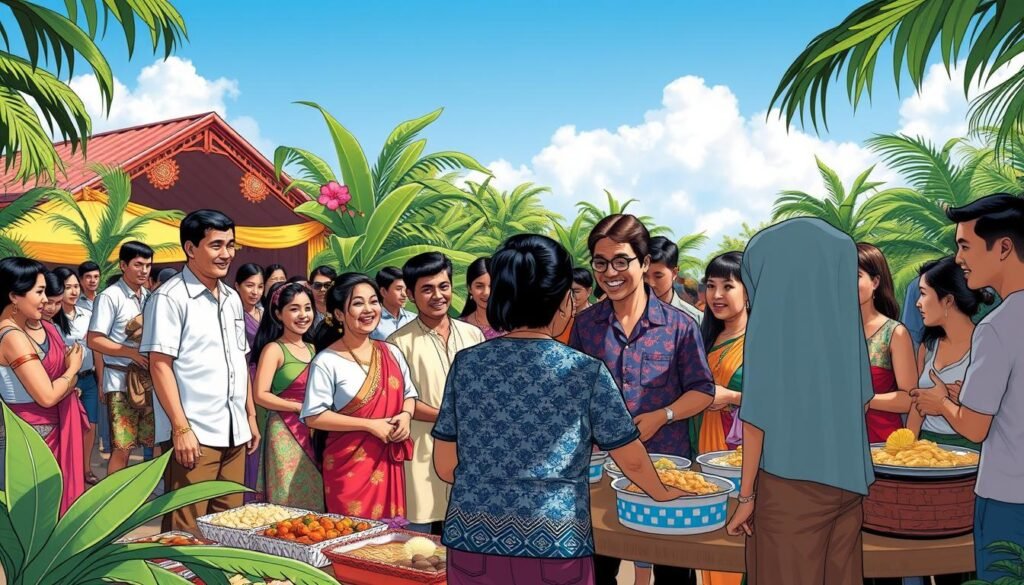
In conclusion, traditional Filipino values and beliefs are vital to the country’s culture and community. Understanding and appreciating these values helps us see the Filipino way of life. It shows the importance of tradition and community in Filipino culture.
| Value | Description |
|---|---|
| Bayanihan | Emphasizes the importance of unity and collective effort |
| Hospitality | Reflects the warm and welcoming nature of Filipinos towards guests |
Celebrating Filipino Festivals
Filipino festivals are a big part of the country’s heritage. They show off its rich culture and traditions. These festivals help teach people about the country’s history and values.
Some of the most popular Filipino festivals include:
- Sinulog Festival: A cultural extravaganza that showcases the country’s rich heritage
- Ati-Atihan: A dance and celebration that commemorates the arrival of Malay datus in the island of Panay
- Pahiyas Festival: A festival that celebrates the patron saint of farmers, San Isidro Labrador, and showcases the town’s agricultural products
These festivals are more than just celebrations. They are chances for education and cultural exchange. They bring people together, creating a sense of community and social bonding.
By joining in these festivals, people can learn about the country’s history, culture, and traditions. This is key for education and preserving heritage.
| Festival | Location | Significance |
|---|---|---|
| Sinulog Festival | Cebu City | Celebrates the country’s rich heritage and cultural traditions |
| Ati-Atihan | Kalibo | Commemorates the arrival of Malay datus in the island of Panay |
| Pahiyas Festival | Lucban, Quezon | Celebrates the patron saint of farmers, San Isidro Labrador |
Filipino Cuisine: A Taste of Culture
Filipino cuisine shows the country’s rich culture. It combines unique flavors and ingredients. This brings people together through food.
Food is key in Filipino culture. It helps create connection and community among people.
Traditional dishes like adobo and sinigang are more than just food. They carry cultural value. These dishes are shared at gatherings, strengthening community and connection.
Traditional Dishes and Their Significance
Some beloved traditional Filipino dishes are:
- Lechon, a whole roasted pig for special occasions
- Longganisa, a breakfast sausage
- Turon, a fried snack with banana and jackfruit
These dishes are not just delicious. They also represent the country’s history and traditions.
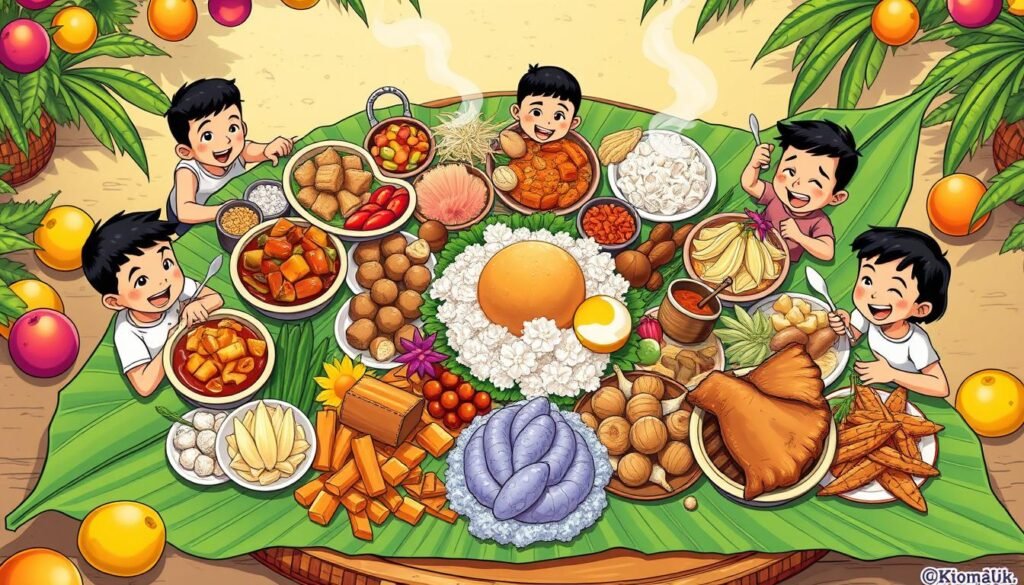
The Role of Food in Social Gatherings
Filipino food culture values sharing meals. It promotes connection and community among people. This is seen in the country’s love for gatherings like potlucks and fiestas.
Language and Dialects: A Window to Culture
Language is key in shaping culture and identity. In the Philippines, Filipino is the national language, but there are many local variations and dialects. Education and heritage are closely tied to language. They are passed down through stories, traditions, and cultural practices.
The line between languages and dialects can be blurry. Some languages have many dialects, while others are seen as distinct languages because of history and culture. For instance, Mandarin, Cantonese, and Taiwanese are often called dialects of Chinese. Yet, they have big linguistic differences.
It’s vital to understand language’s role in culture and identity. This knowledge helps in promoting education and keeping heritage alive. By valuing language and dialects, we can support cultural diversity and understanding.
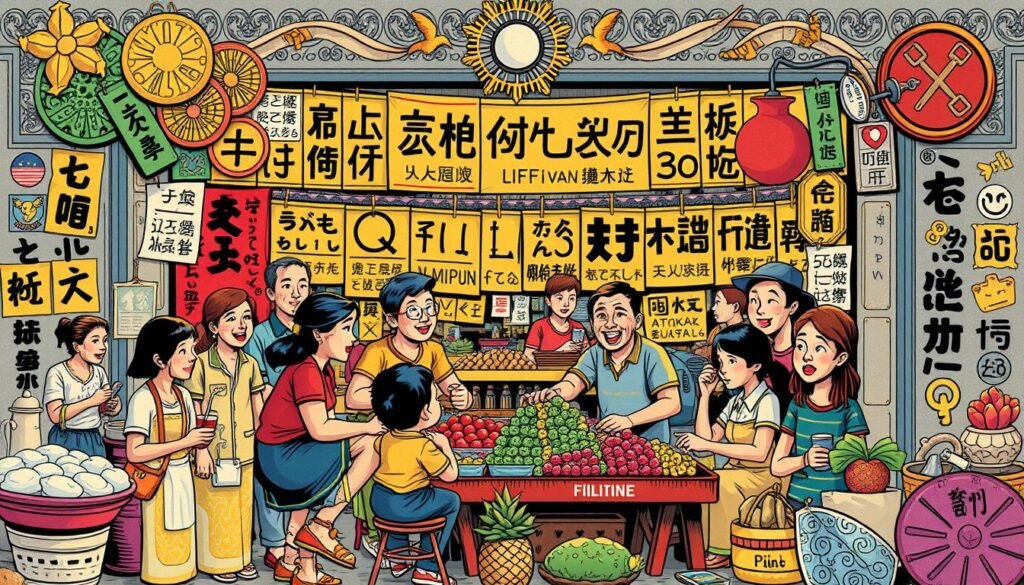
| Language | Culture | Identity |
|---|---|---|
| Filipino | Philippine culture | Filipino identity |
| English | Western culture | Global identity |
In summary, language and dialects are vital parts of culture and identity. By focusing on education and heritage, we can boost cultural diversity and understanding.
Filipino Arts and Crafts
Filipino arts and crafts are key to the country’s tradition and community. The Philippines has a rich cultural heritage. It includes various indigenous art forms and dances that show cultural traditions across different tribal groups.
Some famous indigenous musical instruments in the Philippines are flutes, drums, and guitars. They are made from bamboo, animal skin, and seeds. These instruments are used in tribal dances and rituals. They show the country’s diverse cultural influences and traditions.
Weaving and Textiles: Stories in Threads
Weaving in the Philippines uses fibers like cotton, abaca, and banana fiber. It creates textiles like pinilian and T’nalak. The Banton cloth is the oldest surviving ikat textile in Southeast Asia. It dates back to the 13th to 14th centuries.
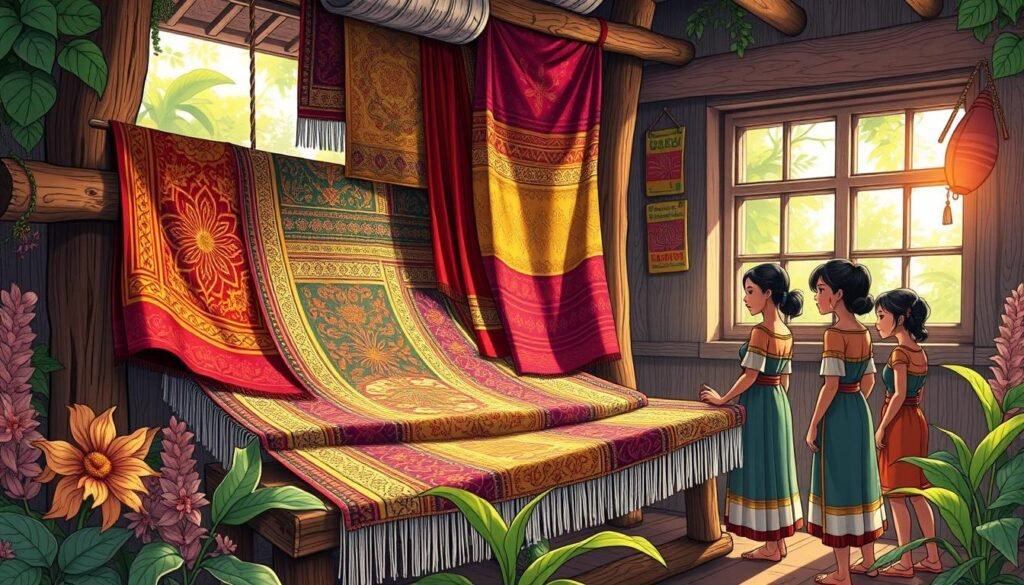
Traditional Music and Dance: Cultural Expressions
Traditional music and dance in the Philippines are key to its cultural heritage. The National Commission for Culture and the Arts in the Philippines categorizes Filipino arts. They are divided into traditional and non-traditional, each with sub-categories.
| Art Form | Description |
|---|---|
| Weaving | Utilizes various fibers to create textiles |
| Traditional Music | Includes instruments such as flutes and drums |
| Traditional Dance | Embodies cultural traditions across different tribal groups |
These art forms are vital for promoting cultural heritage and education. They are essential to the country’s tradition and community.
Literature and Storytelling Traditions
Philippine literature shows the country’s rich heritage and education. It highlights the importance of values in culture and education. Literature and storytelling play key roles in sharing cultural heritage and education.
Storytelling has been a cornerstone of human culture, even before writing existed. It’s linked with myths and passed down through generations. In the Philippines, folktales and works by famous authors have shaped identities.
Folktales: Lessons from the Past
Folktales share common themes worldwide. In the Philippines, stories like Malakas at Maganda teach about life, love, and community. They’ve been passed down for generations.
Prominent Filipino Authors and Their Works
Authors like Jose Rizal, Emilio Aguinaldo, and Nick Joaquin have enriched Philippine literature. Their works reflect the country’s heritage and promote education and cultural awareness.
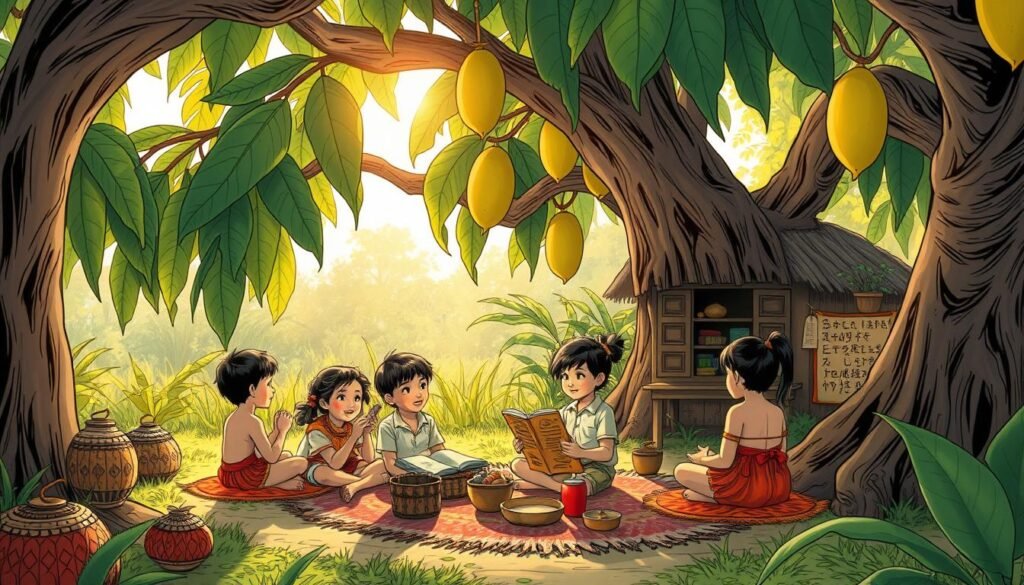
Efforts are underway to preserve Philippine literature and storytelling for the young. Books, prose, and digital platforms are used to share stories and promote cultural heritage and education.
| Author | Work | Significance |
|---|---|---|
| Jose Rizal | Noli Me Tangere | Reflection of Philippine society during the Spanish colonial period |
| Emilio Aguinaldo | Resena Veridica de la Revolucion Filipina | Historical account of the Philippine Revolution |
| Nick Joaquin | May Day Eve | Reflection of Philippine culture and traditions |
By promoting Philippine literature and storytelling, we can keep the country’s heritage alive. It also helps in education and cultural awareness.
The Role of Education in Cultural Sharing
Education is key in teaching us about different cultures. It helps us understand and appreciate the rich heritage of countries like the Philippines. By learning about Filipino history and culture, students can see the beauty of diversity.
Studies show that learning about cultures can break down stereotypes. It makes us better at talking to people from different backgrounds. This leads to a better learning environment, where everyone can grow and succeed.
Here are some ways to make education more culturally aware:
- Make history lessons more diverse by including other cultures
- Encourage students to learn about their own cultures
- Provide a safe space for discussions and teamwork
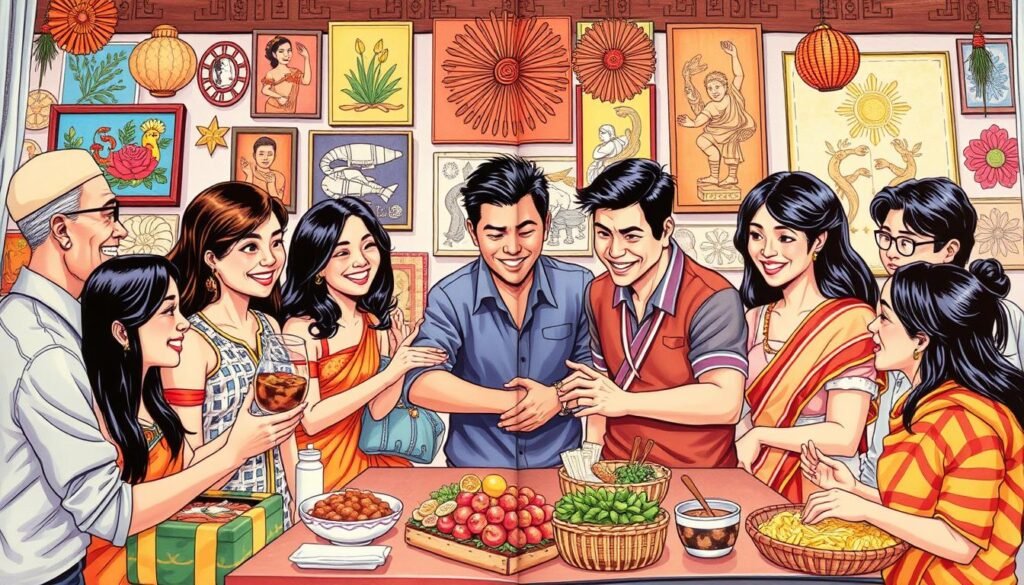
Education helps us connect and appreciate different cultures. It’s important because culture shapes our imagination and society. So, we should focus on cultural education and diversity in schools.
Celebrating Diversity in Filipino Culture
Filipino culture is a mix of Eastern and Western influences. It shows the country’s history of resilience and adaptability. With over 7,000 islands, the Philippines offers a wide range of cultural experiences. Embracing cultural diversity helps unite and boost national pride.
Keeping heritage alive is key for the country’s growth. By adding cultural values to policies, education, and planning, the Philippines can build a strong national identity. Art and culture are vital in shaping the nation and helping it grow.
Some key aspects of Filipino culture include:
- Festivals like Sinulog and Ati-Atihan, which show the lively spirit of Filipino culture
- The “mano” gesture, a sign of respect, and using “po” and “opo” to show politeness
- Filipino hospitality, which means being warm, generous, and welcoming to guests
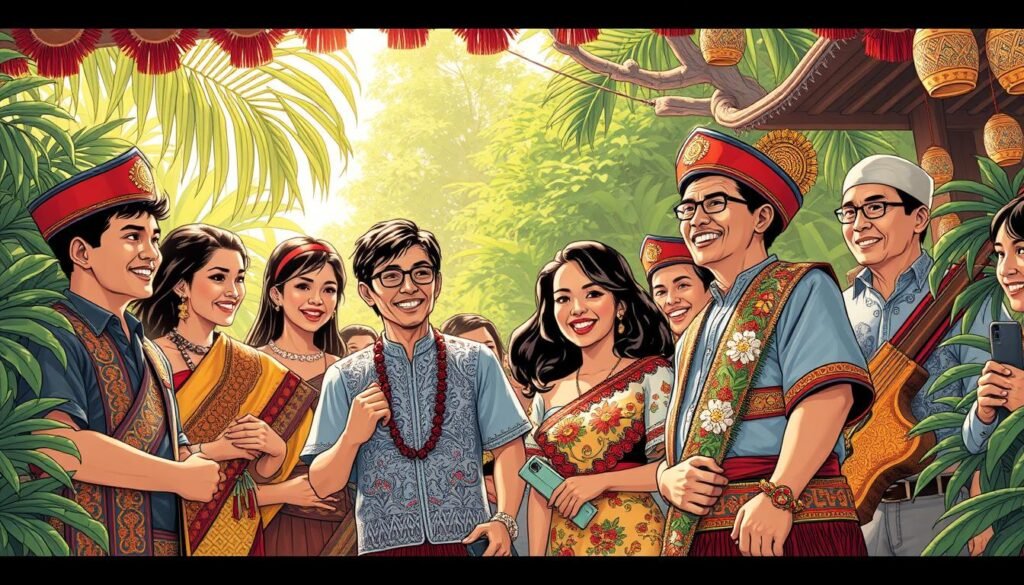
By focusing on education and cultural awareness, the Philippines can unite more. Regional differences are seen as subcultures that add to the broader culture. They highlight unique traits but unite under the national identity.
| Cultural Aspect | Significance |
|---|---|
| Festivals | Demonstrate vibrant and celebratory spirit |
| Traditional gestures | Signify respect and politeness |
| Hospitality | Emphasizes warmth and generosity |
Shared Experiences: The Filipino Community Abroad
The Filipino community abroad is lively and varied. Many people keep a strong connection to their culture. A study on Filipino storytelling shows how shared experiences help keep cultural connection and community strong.
Some interesting facts about the Filipino community abroad include:
- Percentage of Filipino expats living in San Francisco: 10%
- Number of attendees in San Francisco Filipino festivals and events annually: 10,000
- Ratio of Filipino-owned businesses in the Bay Area: 1:5
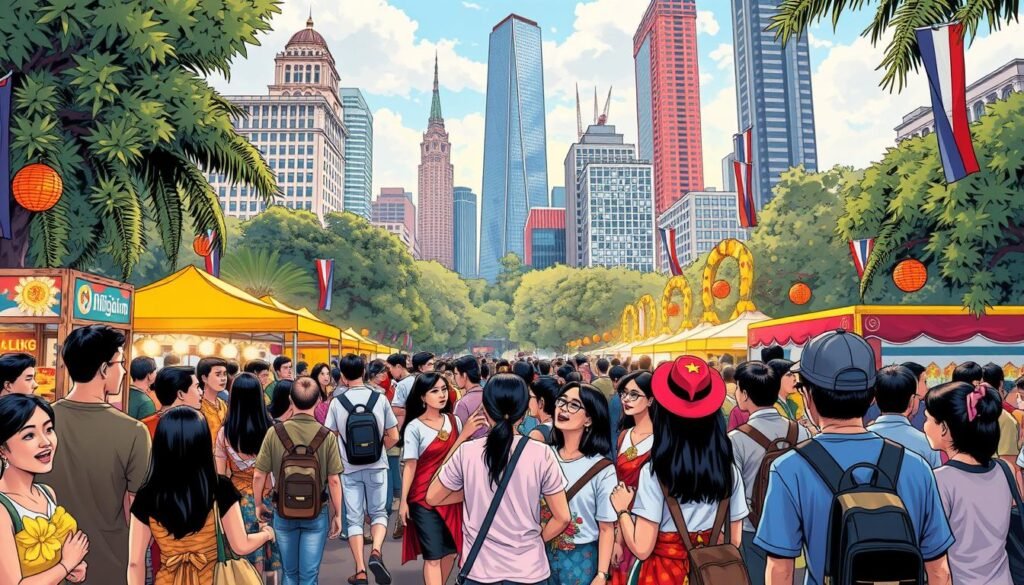
These facts show how big and active the Filipino community is abroad. By sharing their stories and traditions, Filipino expats keep their heritage alive. They also build a supportive community overseas.
Maintaining Cultural Connections Abroad
Filipino expats can keep cultural ties by joining festivals, supporting Filipino businesses, and volunteering. These actions help create a sense of community and connection among them.
Festivals and Events in the Diaspora
Festivals and events are key in celebrating cultural heritage and connection among Filipino expats. They offer chances for expats to gather, share stories, and celebrate their traditions.
| Event | Attendance | Location |
|---|---|---|
| Filipino Festival | 10,000 | San Francisco |
| Filipino Independence Day Celebration | 5,000 | New York |
By taking part in these events, Filipino expats can stay connected to their culture. They also build a supportive community overseas.
Social Media: A New Platform for Cultural Sharing
Social media is a big part of our lives today. Billions of people use Facebook, Instagram, and YouTube to connect and share. It’s a powerful tool for sharing culture and heritage.
Facebook and Instagram have huge user bases. They have 1.82 billion and 500 million users daily. This makes social media a great place for cultural sharing.
Using social media for culture has many benefits. It helps reach more people and improves cultural awareness.
- Increased reach and accessibility
- Improved engagement and interaction
- Enhanced cultural awareness and appreciation
For instance, online campaigns for Filipino heritage have been successful. They use TikTok and Instagram to share cultural content. This includes traditional music and dance, engaging users with hashtags and challenges.
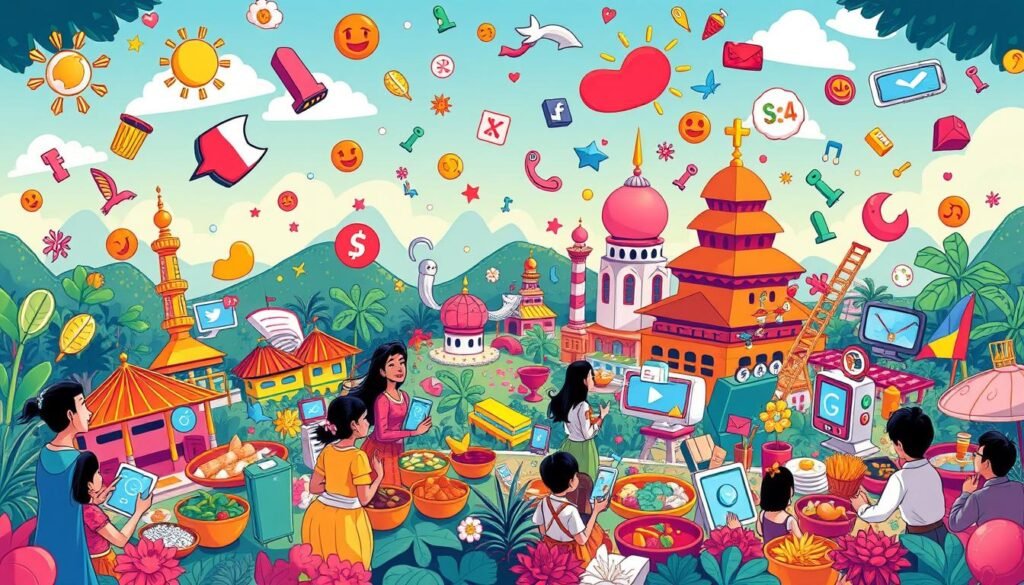
Social media is changing how we learn and share culture. Its impact will grow as more people use it.
| Platform | Daily Active Users | Cultural Content Engagement |
|---|---|---|
| 1.82 billion | 35% | |
| 500 million | 28% | |
| TikTok | 500 million | 40% |
Collaboration with Other Cultures
Working together with people from different cultures is key to building a strong connection and community. When we collaborate, we share our unique views and experiences. This makes our community more diverse and welcoming.
To form strong bonds, we need to trust, understand, and share common goals with people from various backgrounds.
Studies show that diverse teams can outperform single-culture teams. They bring different ways of solving problems, leading to new ideas. Including people from different cultures in decision-making makes our decisions better.
Here are some ways to connect with people from other cultures:
- Making a conscious decision to establish friendships with people from other cultures
- Putting oneself in situations where they can meet individuals from different cultures
- Examining biases and asking questions about cultures, customs, and views
- Reading about other people’s cultures and histories
- Listening to people narrate their stories and noticing differences in communication styles and values
By taking these steps and being open to learning, we can create a strong connection with people from diverse backgrounds. This leads to a more harmonious and inclusive society.
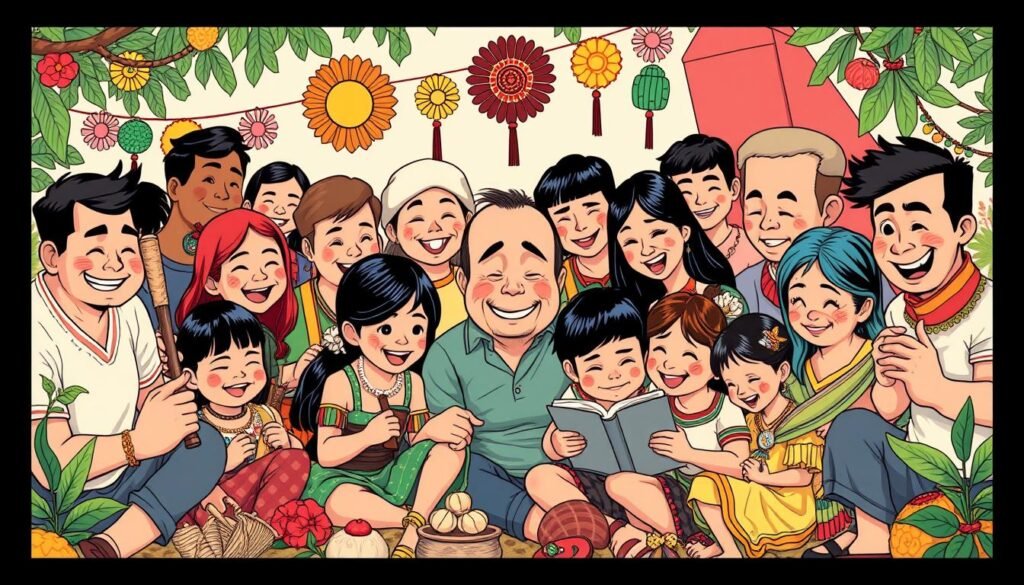
Collaboration with other cultures is vital for a strong connection and community. By embracing our differences, we can build a society where everyone can thrive.
| Cultural Diversity | Benefits |
|---|---|
| Varied problem-solving approaches | More innovative solutions |
| Diverse perspectives and experiences | A more inclusive and diverse community |
| Building trust, understanding, and shared goals | A stronger connection and community |
Global Recognition of Filipino Culture
Filipino culture is now known worldwide. Its heritage and traditions shine in international festivals and competitions. The Philippines’ global events showcase its education system and rich cultural diversity.
The culture of the Philippines is united thanks to an educational system from the United States. Filipinos have expanded it. This system promotes Filipino heritage and education globally.
Filipino cuisine is becoming more popular worldwide. Restaurants and food trucks are recognized in cities globally. Filipino artists, filmmakers, and musicians are also gaining international fame. Their work is shown in international festivals and competitions.
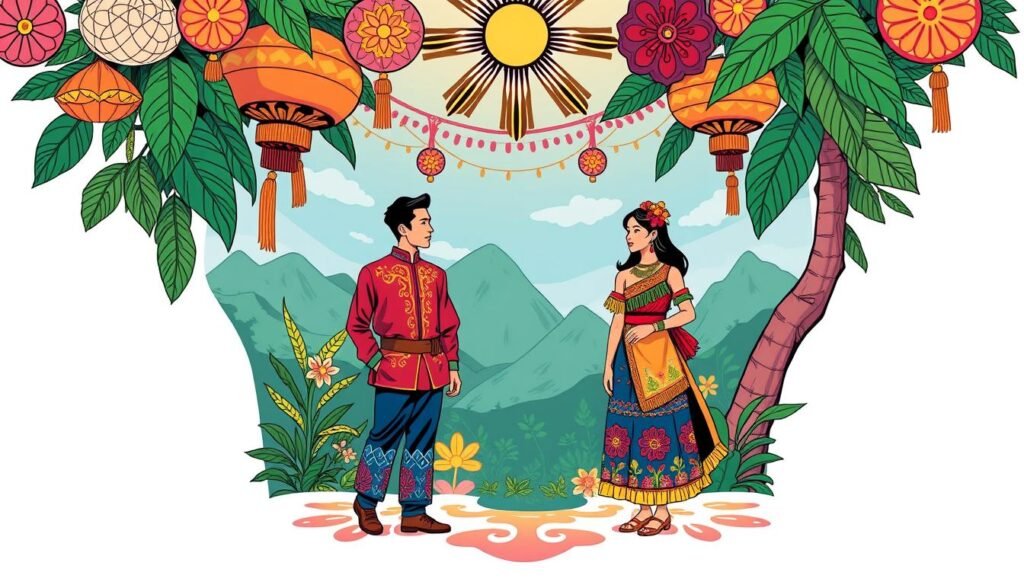
- Filippo cuisine being recognized as one of the most popular cuisines in the world
- Filippo artists and musicians gaining international recognition
- Filippo films being showcased in international film festivals
In conclusion, the global recognition of Filipino culture shows the country’s rich heritage. It also highlights its efforts to promote education and cultural diversity worldwide.
| Category | Example |
|---|---|
| Filipino Cuisine | Adobo, Lechon, Sinigang |
| Filipino Artists | Tom Cunanan, Margarita Manzke |
| Filipino Films | Heneral Luna, Goyo: Ang Batang Heneral |
The Future of Filipino Cultural Sharing
The future of Filipino cultural sharing depends on the connection between the Filipino community and the next generation. It’s key to share Filipino culture with the young to keep it alive. Consul General Maria Lourdes Salcedo says Filipino-Australians have kept their values strong, even in tough times like the pandemic and bushfires.
The Filipino community is vital in keeping culture alive. Many Filipinos join cultural events, like the Australia Day Festival in Melbourne. Rowena De Guzman, who moved to Australia in 1991, thinks it’s important to show off Filipino values.
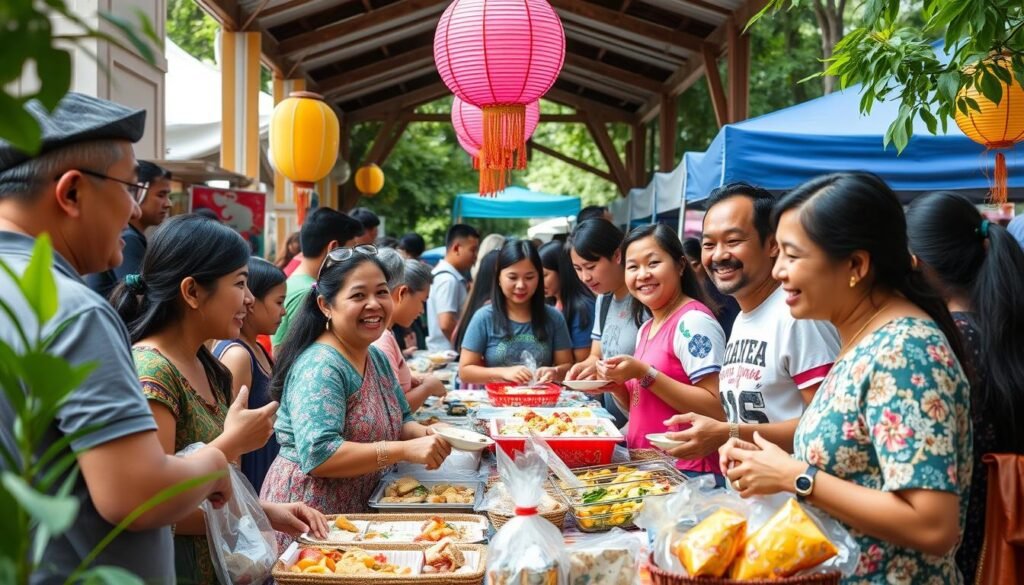
Here are some ways to share Filipino culture with the next generation:
- Integrate Filipino history and culture into school curricula
- Host cultural events and festivals to show off traditions and values
- Encourage young Filipinos to join in cultural activities, like dance and music
For more on Filipino cultural heritage, check out this website. It dives deep into the country’s rich cultural history.
| Event | Location | Description |
|---|---|---|
| Australia Day Festival | Melbourne | Showcases Filipino culture and creativity |
| Looking for Juan Outdoor Banner Show | Philippines | Promotes Filipino art and culture |
Challenges to Cultural Preservation
Cultural preservation is a complex issue. Several challenges can impact efforts to protect and promote cultural heritage. One big challenge is urbanization. It can lead to the loss of cultural traditions and practices.
As cities grow, cultural heritage sites and traditional practices may be forgotten. This is a big problem.
Another challenge is the lack of education and awareness. Many people don’t understand the importance of preserving cultural heritage. This is where education plays a key role in promoting cultural heritage.
Some of the challenges to cultural preservation include:
- Cultural erosion due to urbanization
- Lack of education and awareness
- Insufficient funds and resources
- Climate change and natural disasters
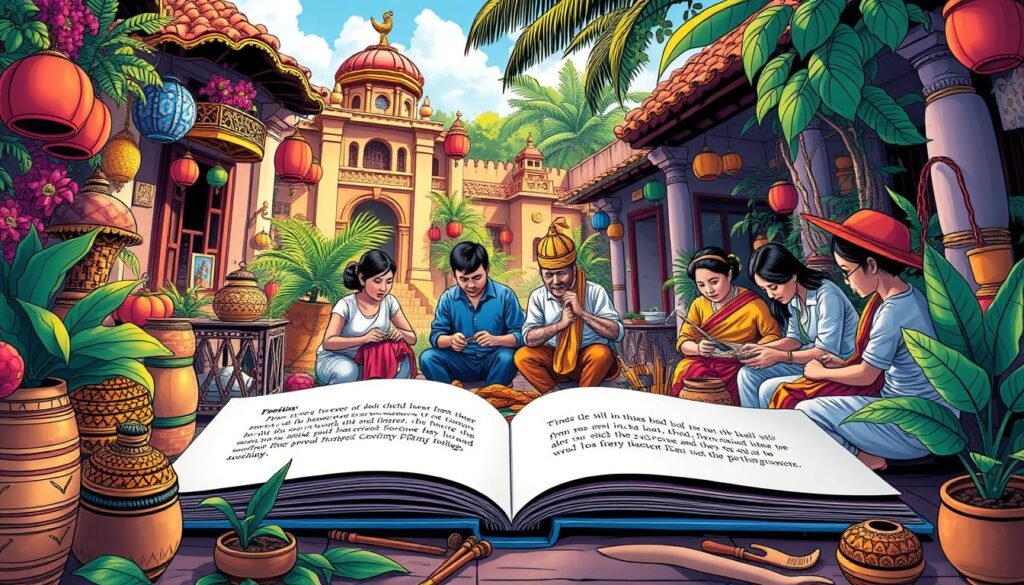
To address these challenges, we need a broad approach. This involves government agencies, community organizations, and individuals. By working together, we can protect cultural heritage for future generations.
| Challenge | Impact | Solution |
|---|---|---|
| Cultural erosion | Loss of cultural traditions | Education and awareness |
| Lack of funds | Insufficient resources | Government support and community involvement |
| Climate change | Destruction of cultural heritage sites | Sustainable practices and conservation efforts |
Conclusion: The Ongoing Journey of Sharing
Exploring Filipino culture shows us that sharing and preserving it is a never-ending task. Each person has a big role in teaching and celebrating this rich heritage. They can connect, learn, and honor the traditions that make us Filipino.
The Role of Individuals in Cultural Education
Everyone can help by joining community events and sharing their stories. By embracing values like bayanihan and hospitality, we build a sense of community. This helps us make connections that go beyond borders.
Call to Action: Embrace and Share Filipino Culture
Keeping Filipino culture alive is something we all must do together. We invite everyone to dive into the traditions and share what they learn. This way, we make sure Filipino culture stays vibrant and inspires future generations.
FAQ
What is the significance of sharing Filipino culture?
Sharing Filipino culture helps connect different communities. It keeps the Philippines’ rich heritage alive. This heritage was shaped by Spanish rule and Catholicism.
How does education play a role in preserving and promoting Filipino culture?
Education is key in keeping Filipino culture alive. By teaching Filipino history and culture, students learn to appreciate it. This helps them understand and value their heritage.
What are some traditional Filipino values and beliefs?
Filipino values include Bayanihan, which is about community and helping each other. Hospitality is also very important in Filipino culture.
What are some of the significant Filipino festivals and their cultural significance?
Festivals like Sinulog, Ati-Atihan, and Pahiyas showcase Filipino culture. They feature traditional music, dance, and art.
How does Filipino cuisine contribute to cultural connection and community?
Filipino food is a big part of our culture. It brings people together and helps build community. Traditional dishes are important in our identity.
What is the importance of language and dialects in Filipino culture?
Language is vital in Filipino culture. It connects us and shows our diversity. The national language and local dialects reflect our rich cultural identity.
What are the significant art forms in Filipino culture?
Filipino art includes weaving, music, and dance. These art forms are deeply meaningful and help build community.
How does the literary heritage of the Philippines shape cultural identity?
The Philippines’ literature, including folktales and famous authors, shapes our identity. It fosters cultural connections and understanding.
What challenges do Filipino communities face in preserving their cultural heritage?
Filipino communities face challenges like urbanization and stereotypes. Education is key in overcoming these and preserving our heritage.
How can individuals contribute to the ongoing journey of sharing Filipino culture?
People can help share Filipino culture by learning and participating in cultural events. This strengthens our identity and appreciation for our heritage.
Source Links
- PDF – https://www.crvp.org/publications/Series-III/III-7.pdf
- Beyond Karaoke: How Filipino Values Shape Us as International Educators – https://www.linkedin.com/pulse/beyond-karaoke-how-filipino-values-shape-us-educators-dominguez-adkjf
- Family: A Crucial Connecter to My Filipino Heritage – Hear Our Voices Magazine – https://hearourvoicesmag.com/family-a-crucial-connecter-to-my-filipino-heritage/
- Sharing of cultural values and heritage through storytelling in the digital age – https://pmc.ncbi.nlm.nih.gov/articles/PMC9990260/
- Frontiers | Sharing of cultural values and heritage through storytelling in the digital age – https://www.frontiersin.org/journals/psychology/articles/10.3389/fpsyg.2023.1104121/full
- Filipino values – https://en.wikipedia.org/wiki/Filipino_values
- 30 Filipino Values: Cultural Beliefs That Shape Behaviors – https://jefmenguin.com/filipino-values/
- No title found – https://www.holidify.com/pages/festivals-in-philippines-5406.html
- This is Our Strength: Why Filipinos Celebrate Fiestas and Festivals — BOSFilipinos – https://www.bosfilipinos.com/blog/2019/3/20/this-is-our-strength-why-filipinos-celebrate-fiestas-and-festivals
- Top 20 Philippine Festivals to Attend in 2025: A Monthly Guide – https://www.traveloka.com/en-ph/explore/tips/guides-festivals-philippines/63538
- Filipino Recipes As Legacies Of Love: What Filipino Food Culture Taught Me – https://www.shopcambio.co/blogs/news/filipino-recipes-as-legacies-of-love-what-filipino-food-culture-taught-me?srsltid=AfmBOoo3Bfrjnlb5l43H9CkmDnhen_xzYGwiOun7ausFZ7YqyjHZ7F__
- Flavours of the Philippines – Nourish & Tempt – https://www.nourishandtempt.com/flavours-of-the-philippines/
- Sharing Tasty Traditions from Around the World – https://teachwithepi.com/blog/sharing-tasty-traditions-around-world
- There’s No Such Thing as a ’Language’ – https://www.theatlantic.com/international/archive/2016/01/difference-between-language-dialect/424704/
- The power of language: How words shape people, culture – https://news.stanford.edu/stories/2019/08/the-power-of-language-how-words-shape-people-culture
- Culture, language and identity – Understanding racism – https://racismnoway.com.au/about-racism/understanding-racism/the-importance-of-culture-language-and-identity/
- The filipino arts crafts/ Art appreciation – https://www.slideshare.net/slideshow/the-filipino-arts-crafts-art-appreciation/273823533
- Arts in the Philippines – https://en.wikipedia.org/wiki/Arts_in_the_Philippines
- Crafting Innovation: Empowering Local Arts and Crafts through Science – DOST-NCR – https://ncr.dost.gov.ph/crafting-innovation-empowering-local-arts-and-crafts-through-science/
- Native Knowledge 360°—Celebrating Native Cultures Through Words: Storytelling and Oral Traditions – https://americanindian.si.edu/nk360/informational/storytelling-and-oral-traditions
- Storytelling and Cultural Traditions – https://education.nationalgeographic.org/resource/storytelling-and-cultural-traditions/
- Storytelling – https://en.wikipedia.org/wiki/Storytelling
- The Importance of Multicultural Education – School of Education – https://drexel.edu/soe/resources/student-teaching/advice/importance-of-cultural-diversity-in-classroom/
- The Impact of Culture on Education – https://lcps.org.uk/impact-of-culture-on-education/
- Discover Filipino Culture: Festivals, Traditions, and Values – https://makeyourasia.com/philippines/filipino-culture.html
- Unity in Diversity – https://woodenxspoon.wordpress.com/2017/01/25/unity-in-diversity/
- Finding Community as a Filipino Expat: A Guide to Staying Connected to Home – https://medium.com/@trixiadonne/finding-community-as-a-filipino-expat-a-guide-to-staying-connected-to-home-6b975ce1122e
- PDF – https://www.arcjournals.org/pdfs/ijsell/v4-i1/8.pdf
- The Impact Of Social Media And Tech Platforms On Society And Culture – https://russewell.medium.com/the-impact-of-social-media-and-tech-platforms-on-society-and-culture-96fc67996195
- The Impact of New Social Media on Intercultural Adaptation – https://digitalcommons.uri.edu/cgi/viewcontent.cgi?article=1230&context=srhonorsprog
- Chapter 27. Working Together for Racial Justice and Inclusion | Section 2. Building Relationships with People from Different Cultures | Main Section – https://ctb.ku.edu/en/table-of-contents/culture/cultural-competence/building-relationships/main
- Collaboration Across Cultures: Fostering Teamwork in a Diverse Workforce | Generation – https://www.generation.org/news/collaboration-across-cultures-fostering-teamwork-in-a-diverse-workforce/
- Filipino – Core Concepts – https://culturalatlas.sbs.com.au/filipino-culture/filipino-culture-core-concepts
- Bridging Cultures: How Overseas Filipinos Shape the Philippines – https://medium.com/@nipinodotcom/bridging-cultures-how-overseas-filipinos-shape-the-philippines-2deee0e27062
- Philippines – Culture, Diversity, Traditions | Britannica – https://www.britannica.com/place/Philippines/Cultural-life
- ‘Nurture our culture for the future generation’: Filipinos on preserving culture in Australia – https://www.sbs.com.au/language/filipino/en/podcast-episode/nurture-our-culture-for-the-future-generation-filipinos-on-preserving-culture-in-australia/yp1is6b6e
- ONLY IN THE PHILIPPINES – Google Arts & Culture – https://artsandculture.google.com/story/only-in-the-philippines-center-for-art-new-ventures-sustainable-development-canvas/zgXRkeopr5qoJQ?hl=en
- The Future is Filipino! – https://www.linkedin.com/pulse/future-filipino-ray-lansigan-ylzfc
- What are the challenges of preserving culture in a diverse society? – https://www.linkedin.com/advice/1/what-challenges-preserving-culture-diverse-ja8xc
- Practices and challenges of cultural heritage conservation in historical and religious heritage sites: evidence from North Shoa Zone, Amhara Region, Ethiopia – npj Heritage Science – https://www.nature.com/articles/s40494-022-00802-6
- Tracking an inquiry – snapshot reflections from an ongoing journey! – https://www.linkedin.com/pulse/tracking-inquiry-snapshot-reflections-from-ongoing-journey-cooper
- Conclusion: The Ongoing Journey Towards Empowering Refugee Communities – FasterCapital – https://fastercapital.com/topics/conclusion:-the-ongoing-journey-towards-empowering-refugee-communities.html

